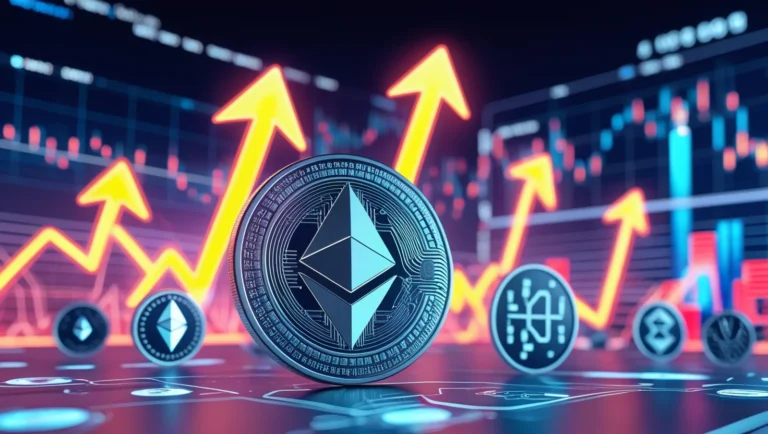Finally US-India Trade Deal Near Closure: Explore the impact on crypto

After months of high-stakes negotiations, India and the United States appear closer than ever to striking a long-anticipated trade agreement. President Donald Trump announced that Washington was “close to making a deal with India,” even as his administration imposed steep tariffs on 14 other countries.
This potential agreement could have sweeping consequences—not only for traditional sectors like agriculture and manufacturing but also for emerging industries such as cryptocurrencies, blockchain infrastructure, and digital payments.
In this in-depth analysis, we’ll explore:
- Who is leading these negotiations
- Why the deal matters now
- How it could reshape India’s economic landscape
- What crypto investors and blockchain builders should watch for
- How tariff timelines impact global market sentiment
Who Is Behind the Deal?
- Rajesh Agrawal, India’s Special Secretary in the Ministry of Commerce and Industry, who led the Indian delegation to Washington.
- The Office of the United States Trade Representative (USTR), the US body responsible for developing and recommending trade policy to the President.
- US President Donald Trump, personally championing reciprocal tariffs and trade reforms as part of his broader economic agenda.
This is not a casual handshake agreement. Both governments have invested years of diplomatic capital to try to bring their massive economies into closer alignment.
What’s at Stake: The Big Picture
The US and India have been negotiating over:
- Tariff reductions on industrial and agricultural goods
- Market access for US dairy and genetically modified crops
- Greater export opportunities for Indian labor-intensive sectors like garments, leather, and footwear
- Frameworks to boost digital trade and data flows
President Trump has already imposed or threatened tariffs of up to 40% on countries with whom the US has trade deficits. Although India hasn’t been officially sent such a letter yet, the possibility remains if the deal falls apart.
During their last meeting, Trump and Prime Minister Narendra Modi set an ambitious target: doubling bilateral trade to $500 billion by 2030.
But beneath the headlines, there’s another dimension: the impact on crypto adoption and blockchain trade routes.
Why Crypto Investers Should Pay Attention
Many in the crypto community might assume traditional trade talks are irrelevant to digital assets. In reality, these negotiations set the tone for regulatory clarity, taxation, and cross-border flows that underpin the crypto economy.
Here’s why this matters:
- Tariffs Influence Fiat Liquidity:
High tariffs restrict cash flow between nations. For crypto exchanges in India relying on USD liquidity, fewer dollars in circulation could dampen trading volumes. - Digital Trade Provisions:
The deal is expected to address data localization and cross-border payments—critical for blockchain companies operating internationally. - Investor Confidence:
When nations resolve trade disputes, it often boosts investor sentiment across asset classes, including Bitcoin and Ethereum. - Sanctions and Compliance:
Clearer trade agreements reduce the likelihood of sudden sanctions that could disrupt crypto-fiat ramps. - Adoption of Blockchain in Trade Finance:
The US and India are both exploring blockchain-based trade finance tools. A smoother trade environment could accelerate these pilots.
The Negotiation Timeline: Deadlines and Pressure Points
April 2, 2025:
President Trump announced “Liberation Day” tariffs up to 40%, with a 90-day pause.
July 8, 2025:
Original deadline for India to finalize the deal, avoiding a reimposition of tariffs.
August 1, 2025:
New deadline for 14 countries that received letters from the US.
Current Status:
Indian negotiators have tabled their final proposals. If the US doesn’t agree, India could still pivot to the August 1 deadline—but officials insist they won’t compromise on core issues like dairy imports and GM crops.
Why Is Agriculture the Sticking Point?
New Delhi has traditionally excluded agriculture from free trade deals. Agriculture sustains nearly half of India’s 1.4 billion citizens, despite contributing only 16% of GDP.
US demands include:
- Import of genetically modified soybean meal and DDGS.
- Market access for US cow milk and dairy products.
Indian policymakers fear cheap imports could devastate rural livelihoods and ignite political backlash.
But why does this matter to crypto? Because agricultural trade is deeply intertwined with rural digitization and payment systems—areas ripe for blockchain disruption. If tariffs block cheap imports, it could indirectly preserve momentum in India’s efforts to digitize agriculture using blockchain supply chain tracking.
Potential Benefits for Crypto and Blockchain
1. Faster Growth in Digital Trade:
Both sides may agree to remove certain non-tariff barriers. This could create an easier environment for cross-border blockchain payments and digital asset services.
2. Investment Clarity:
International venture capital flowing into Indian Web3 startups often depends on predictable trade frameworks.
3. Reduced Volatility:
A positive trade narrative can stabilize India’s currency, indirectly reducing volatility in INR-crypto pairs.
4. Tech Cooperation:
Bilateral deals often include technology transfer provisions that could accelerate India’s blockchain infrastructure.
How This Deal Fits Into the Digital Trade Revolution
While much of the discussion around the US-India trade negotiations focuses on tariffs and agriculture, it’s crucial to understand why digital trade is increasingly at the center of modern agreements.
In 2024 alone, the World Trade Organization estimated that digital trade contributed over $4 trillion to global commerce. For India, a nation aspiring to become a $5 trillion economy, tapping into this digital surge isn’t optional—it’s strategic.
Here’s how this broader shift connects directly to crypto:
- Digital Payment Infrastructure:
When governments collaborate on cross-border trade rules, they also establish standards for how money moves. This includes remittances, stablecoins, and blockchain payment rails. - Data Localization vs. Free Flow of Data:
One of the thorniest issues in US-India negotiations has been data sovereignty. India favors storing certain categories of data locally to protect national security and privacy, while the US champions freer cross-border flows.
This tension directly affects how crypto exchanges, wallets, and decentralized apps can operate across jurisdictions. - Compliance Standards:
New trade deals often lay the groundwork for harmonizing anti-money laundering (AML) and know-your-customer (KYC) rules. For crypto businesses, this can either simplify operations or create new hurdles.
What Crypto Entrepreneurs Should Watch For
If you’re building a blockchain project or investing in digital assets in India, here are four crucial factors to monitor as this deal unfolds:
- Trade-Related Regulatory Announcements
Watch for clauses that reference “digital services,” “electronic transmissions,” or “financial technologies.” Even if crypto isn’t named directly, these provisions often influence how Web3 companies must operate. - Tariff-Linked Currency Volatility
If tariffs kick in, the Indian rupee could depreciate. Historically, INR weakness has spurred higher demand for Bitcoin as a hedge. However, volatility also introduces risks. - Incentives for Blockchain in Trade Finance
Both governments have signaled interest in using blockchain to reduce paperwork and fraud in cross-border shipments. A finalized deal could accelerate pilots and funding in this niche. - Legal Certainty for Digital Asset Taxes
Clarity around what counts as a “digital good” could influence whether certain tokens are taxed as commodities, currencies, or securities. This matters for exchanges and investors alike.
A Global Comparison: India vs. Other Trade Negotiations
To understand why the India-US deal is so consequential, it helps to look at how other countries are approaching similar questions:
- United Kingdom:
Post-Brexit trade agreements have included dedicated chapters on digital trade and cybersecurity. - Vietnam:
Recent US agreements with Vietnam emphasized opening e-commerce and fintech sectors. - European Union:
The EU has adopted some of the world’s strictest data protection laws (GDPR), influencing how exchanges operate.
India’s stance has historically been cautious on digital openness—especially regarding agricultural data and payment processing. But as blockchain’s role in trade expands, India may have no choice but to find middle ground.
Looking Ahead: The Road to $500 Billion in Bilateral Trade
In their joint vision statement, President Trump and Prime Minister Modi said they aimed to double US-India bilateral trade to $500 billion by 2030.
This ambitious target will require not just tariff cuts but also:
- Streamlined customs processes
- Digitization of export-import paperwork
- Stable, transparent rules for fintech and crypto payments
- Collaboration on cybersecurity
For crypto founders and traders, this is an opportunity—and a caution. The same rules that unlock new cross-border flows can also entrench regulatory expectations around transparency and compliance.
What Happens If the Deal Fails?
1. Tariffs of up to 26% on Indian exports could be reimposed.
2. Indian exports of textiles, leather, and possibly digital goods could face higher barriers.
3. Trade uncertainty could spill over into crypto markets, as sentiment weakens and capital outflows accelerate.
The US has already proven willing to impose tariffs on 14 nations. While India was spared the latest letters, failure to finalize terms could put it in the next round of targets.
Broader Economic Implications
Beyond crypto, the stakes are enormous for traditional sectors:
- India’s garment and footwear industries risk losing competitiveness in the US market.
- American firms could find it harder to sell high-end tech and agricultural goods in India.
- Bilateral trade volumes could stagnate or decline, threatening the $500 billion target.
FAQs About the US-India Trade Deal and Crypto
1. Why should crypto investors care about a trade deal on tariffs?
Tariffs impact liquidity, fiat flow, and overall investor sentiment, which can spill into crypto markets.
2. Will this deal directly regulate Bitcoin or Ethereum?
No. But it could establish frameworks around digital trade and cross-border data flows.
3. Could the deal accelerate blockchain adoption in India?
Possibly. If digital trade provisions are included, blockchain-based payments and supply chains will likely get a boost.
4. What happens if the deal fails?
India faces potential tariffs of up to 26%, which could tighten liquidity and weaken INR—affecting INR-crypto trading pairs.
5. Does the deal include provisions for stablecoins?
No official text mentions stablecoins, but data localization and cross-border payment rules will be relevant.
6. How could US demands on agriculture affect crypto?
If India resists GM crop imports, it may preserve the push for domestic blockchain supply chain solutions.
7. When will we know if the deal is finalized?
Negotiators expect clarity between July 8 and August 1, 2025.
Why This Matters for the Future of Crypto in India
This isn’t just another headline about tariffs. It’s a signal about India’s willingness to engage in trade frameworks that impact fintech, digital assets, and cross-border data flows.
Crypto builders, investors, and traders should watch this story closely. A successful deal will likely boost confidence in India as a hub for digital innovation. Failure could trigger market turbulence far beyond traditional trade.






